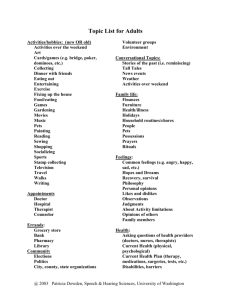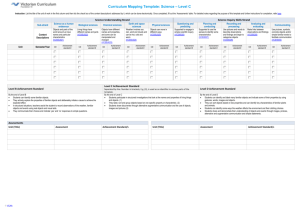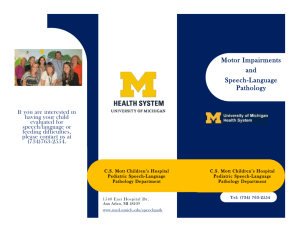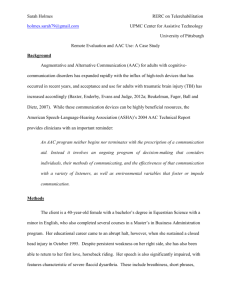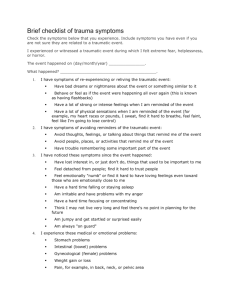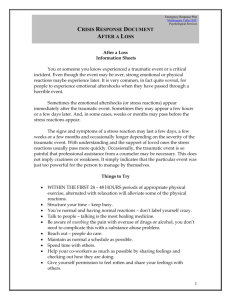TBI & AAC
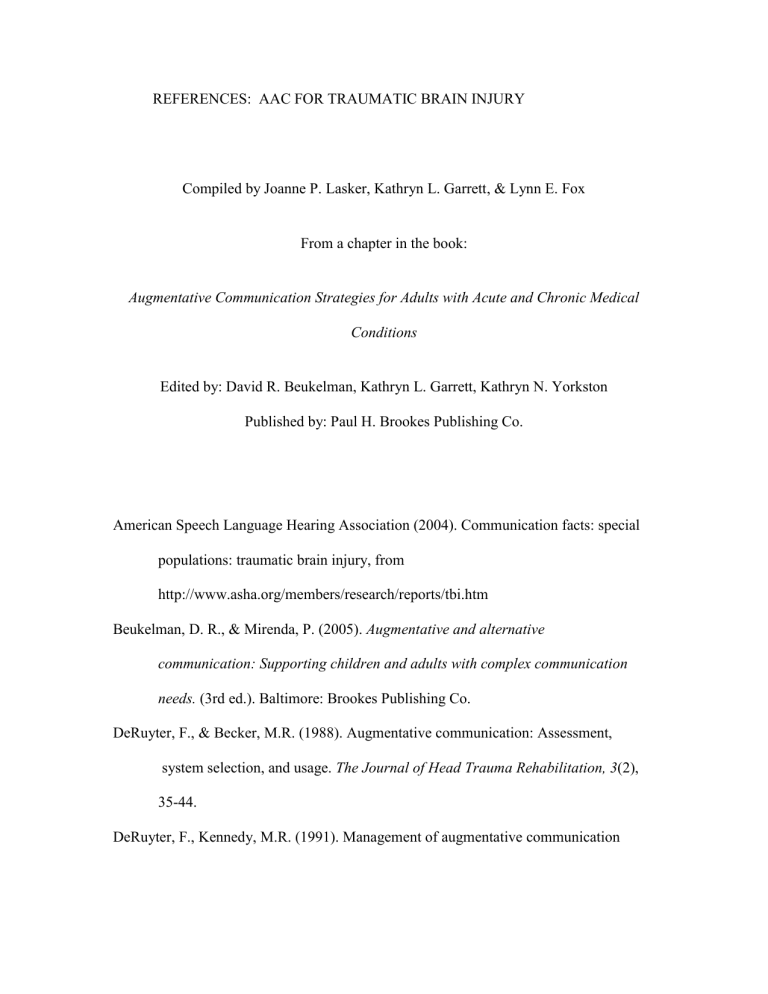
REFERENCES: AAC FOR TRAUMATIC BRAIN INJURY
Compiled by Joanne P. Lasker, Kathryn L. Garrett, & Lynn E. Fox
From a chapter in the book:
Augmentative Communication Strategies for Adults with Acute and Chronic Medical
Conditions
Edited by: David R. Beukelman, Kathryn L. Garrett, Kathryn N. Yorkston
Published by: Paul H. Brookes Publishing Co.
American Speech Language Hearing Association (2004). Communication facts: special populations: traumatic brain injury, from http://www.asha.org/members/research/reports/tbi.htm
Beukelman, D. R., & Mirenda, P. (2005). Augmentative and alternative communication: Supporting children and adults with complex communication needs.
(3rd ed.). Baltimore: Brookes Publishing Co.
DeRuyter, F., & Becker, M.R. (1988). Augmentative communication: Assessment, system selection, and usage. The Journal of Head Trauma Rehabilitation, 3 (2),
35-44.
DeRuyter, F., Kennedy, M.R. (1991). Management of augmentative communication
following traumatic brain injury. In D.R. Beukelman & K.M. Yorkston (Eds.),
Communication disorders following traumatic brain injury: Management of cognitive, language and motor impairments (pp. 317-365). Austin, TX: ProEd.
DeRuyter, F. & LaFontaine L. (1987). The nonspeaking brain injured: A clinical demographic database report. Augmentative and Alternative Communication, 3,
18-25.
Dongilli, P.A., Hakel, M.E., & Beukelman, D.R. (1992). Recovery of functional speech following traumatic brain injury. Journal of Head Trauma Rehabilitation, 7 (2),
91-101.
Doyle M., Kennedy M, Jausalaitis G. & Phillips B (2000). AAC and traumatic brain injury. In D.R. Beukelman, K.M. Yorkston, & J. Reichle (Eds.) Augmentative and alternative communication for adults with acquired neurological disorders (pp
271-304). Baltimore: Brookes Publishing Co.
Fager, S., Hux, K., Beukelman, D.R., & Karantounis, R. (2006). Augmentative and
Alternative Communication Use and Acceptance by Adults with Traumatic Brain
Injury. Augmentative and Alternative Communication, 22 , 37-47.
Hagan, C., Malkamus, D., & Durham, P. (1979). Rehabilitation of the head injured adult:
Comprehensive physical management. Downey, CA: Professional Staff
Association of Rancho Los Amigos Medical Center.
Harris, D. (1982). Communication interaction processes involving nonvocal physically handicapped children. Topics in Language Disorders,
2 , 21-32.
Harris D. & Vanderhaiden G (1980). Augmentative communication
techniques. In R. L. Schiefelbusch (Ed .) Nonspeech language and communication: Analysis and intervention (pp. 259-301). Baltimore:
University Park Press.
Hux, K. (2003). Assisting survivors of traumatic brain injury . Austin: ProEd.
Hux, K., Burke, R., Elliot, J., Ross, R., & Hrnicek, T. (2001). Communication interaction differences between natural speakers and AAC users with traumatic brain injury.
Journal of Medical Speech-Language Pathology, 9 , 71-86.
Keenan, J., & Barnhart, K. (1993). Development of yes/no systems in individuals with severe traumatic brain injuries. Augmentative and Alternative Communication, 9 ,
184-190.
Klauber, M. R., Barrett-Connor, E., Marshall, L. F., & Bowers, S. A. (1981). The epidemiology of head injury: A prospective study of an entire community- San
Diego county, California. American Journal of Epidemiology, 113 , 500-509.
Kraus, J. F. (1995). Epidemiological features of brain injury in children: Occurrence, children at risk, causes and manner of injury, severity and outcomes. In S. H.
Broman & M. E. Michel (Eds.), Traumatic head injury in children (pp. 22-39).
New York: Oxford University Press .
Koester, H., & Levine, S. P. (1996). Effect of a word prediction feature on user performance. Augmentative and Alternative Communication, 12 (3), 155-168.
Ladtkow, M. C., & Culp, D. (1992). Augmentative communication with traumatic brain injury. In K. Y. Yorkston (Ed.), Augmentative communication in the medical setting . Tucson: Communication Skill Builder.
Light, J. C., Beesley, M., & Collier, B. (1988). Transition through multiple augmentative
and alternative communication systems: A three-year case study of a head injured adolescent. Augmentative and Alternative Communication, 4 , 2-14.
Malkamus D., Booth B.J. & Kodimer C. (1980). Rehabilitation of the head injured adult:
Comprehensive cognitive management. Downey, CA.: Professional Staff
Association of Rancho Los Amigos Medical Center.
Naugle, R. I. (1990). Epidemiology of traumatic brain injury in adults. In E. D. Bigler
(Ed.), Traumatic brain injury: Mechanisms of damage, assessment, intervention, and outcome (pp. 69-103). Austin: ProEd.
Newell, A. F., Arnott, J. L., Booth, L., Beattie, W., Brophy, B., & Ricketts, I. W. (1992).
Effect of the "PAL" word prediction system on the quality and quantity of text generation. Augmentative and Alternative Communication, 8 (4), 304-311.
Piche L. & Reichle, J. (1991). Teaching scanning selection techniques.
In J. Reichle, J. York & J. Sigafoos (Eds.).
Implementing augmentative and alternative communication: Strategies for learners with severe disabilities . (pp. 257-274). Baltimore: Paul H. Brookes Publishing.
Rappaport, M., Dougherty, A.M., & Kelting, D.L. (1992). Evaluation of coma and vegetative states. Archives of Physical Medicine and Rehabilitation, 73 , 628-634.
Ratcliff, A. (1994). Comparison on relative demands implicated in direct selection and scanning: Considerations from normal children.
Augmentative and Alternative Communication, 10 (2), 67-74.
Sarno, M.
Buonaguvro, A. & Levita, E. (1986). Characteristics of verbal impairment in closed head injured patients. Archives of Physical Medicine and Rehabilitation ,
67, 400-405.
Tam, C., Reid, D., Naumann, S., & O'Keefe, B. (2002). Effects of word prediction and location of word prediction list on text entry with children with Spina Bifada and
Hydrocephalus. Augmentative and Alternative Communication, 18 , 147-162.
Venkatagiri, H. S. (1993). Efficiency of lexical prediction as a communication acceleration technique. Augmentative and Alternative Communication, 9 , 161-
167.
Venkatagiri, H.S. (1994). Effectiveness of window size on rate of communication in a lexical prediction AAC system. Augmentative and Alternative Communication,
10, 105-112.
Workinger, M., & Netsell, R. (1992). Restoration of intelligible speech 13 years post head injury. Brain Injury, 6 , 183-187 .
Ylvisaker, M. & Feeney, T.J. (1998). Collaborative Brain Injury Intervention. San Diego:
Singular Publishing.
Ylvisaker, M., & Szekeres, S.F. (1998) A framework for cognitive rehabilitation. In M.
Ylvisaker (Ed.) Traumatic brain injury rehabilitation: children and adolescents.
Boston: Butterworth-Heinemann
